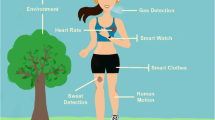Abstract
The SensVest is an item of wearable technology that measures, records and transmits aspects of human physical performance such as heart rate, temperature and movement. The SensVest has been designed for use by science teachers and students to meet their requirements. This paper reports the stages undertaken to design the SensVest, from determining appropriate methods of assessing human performance, to considerations of mounting the technology on the body. Trials have shown that concessions need to be made with ease of use and cost to ensure that the data collected is reliable and usable, with an awareness of the sensors’ limitations. By designing the SensVest with the wearer in mind a system has been developed that is comfortable, does not inhibit normal performance and is wearable. User trials have shown that meaningful, reliable and useful data can be collected using the SensVest.













Similar content being viewed by others
Notes
The Lab of Tomorrow project is a European project with partners from Greece, Germany, Italy, Austria and England. The aim of the project is to develop technologies that can be used to enhance the learning experience. Specifically, the aim is to measure scientific variables from everyday activities, which can be used as the basis of science lessons.
References
Bass L (1995) Is there a wearable computer in your future? In: Proceedings of the IFIP TC/WG2.7 Working Conference on Engineering for Human Computer Interaction, Yellowstone Park, USA, August 1995, pp 3–14
Mann S (1998) Wearable computing as means for personal empowerment. In: Proceedings of the International Conference on Wearable Computing (ICWC-98), Fairfax, VA 12–13 May 1998
Bristow HW, Baber C, Cross J, Wooley S (2002) Evaluating contextual information for wearable computing. In: The Sixth International Symposium of Wearable Computers, Seattle, WA, 7–10 October 2002, pp 179–185
Van Laerhoven K, Schmidt A, Gellersen HW (2002) Multi-sensor context aware clothing. In: The Sixth International Symposium of Wearable Computers. Seattle, WA, 7–10 October 2002, pp 49–56
Hausswirth C, Bigard AX, Chevalier JM Le (1997) The Cosmed K4 telemetry system as an accurate device for oxygen uptake measurements during exercise. Int J Sports Med 18:449–453
Schultz H, Helle S, Heck H (1997) The validity of the telemetric system CORTEX X1 in the ventilatory and gas exchange measurement during exercise. Int J Sports Med 18:454–457
Sirard JR, Pate RR (2001) Physical activity assessment in children and adolescents. Sports Med 31(6):439–454
Mahon AD, Stolen KQ, Gay JA (1998) Using a facemask and sealant to measure respiratory gas exchange in children during exercise. Pediatr Exerc Sci 10:347–355
Åstrand P, Rodahl K (1986) Textbook of work physiology physiological basis of exercise, 3rd edn. McGraw-Hill, London
Kemper HC, Verschuur R (1987) Longitudinal study of maximal aerobic power in teenagers. Ann Hum Biol 14(5):435–444
Norris B, Wilson JR (1995) CHILDATA: the handbook of child measurements and capabilities—data for design safety. Department of Trade and Industry, Consumer Safety Unit, London
Fehling PC, Smith DL, Warner SE, Dalsky GP (1999) Comparison of accelerometers with oxygen consumption in older adults during exercise. Med Sci Sports Exerc 31(1):171–175
Meijer GA, Westerterp KR, Koper H, Hoor FT (1989) Assessment of energy expenditure by recording heart rate and body acceleration. Med Sci Sports Exerc 21(3):343–347
Nielsen M (1938) Cited: Astrand P, Rodahl K (1986) Textbook of work physiology physiological basis of exercise, 3rd edn. McGraw-Hill, London
Eston R, Reilly T (1996) Kinanthropometry and exercise physiology laboratory manual: tests, procedures and data. E & FN Spon, London
Beevers G, Lip GYH, O’Brien E (2001) Blood pressure measurement. Part IV—Automated sphygmomanometry: self blood pressure measurement. BMJ 322:1167–1170
Gemperle F, Kasabach C, Stivoric J, Bauer M, Martin R (1998) Design for wearability. In: Proceedings of the Second International Symposium on Wearable Computers, Pittsburgh, PA, 19–20 October 1998, pp 116–122
Knight JF (2002) The ergonomics of wearable computers: implications for musculoskeletal loading. PhD thesis, School of Manufacturing and Mechanical Engineering, University of Birmingham
Knight JF, Baber C, Schwirtz A, Bristow HW (2002) The comfort assessment of wearable computers. In: Proceedings of the Sixth Iinternational Symposium of Wearable Computers, Seattle, WA, 7–10 October 2002, pp 65–72
Knight JF, Baber C A tool to assess the comfort of wearable computers (in press)
Acknowledgements
The work reported in this paper was supported by a EU Grant reference IST-2000-25076 “Lab of Tomorrow”. The authors would like to acknowledge the work and help of S. Baber who constructed the first SensVest and C. M. Knight who developed the final version of the vest for the SensVest.
Author information
Authors and Affiliations
Corresponding author
Rights and permissions
About this article
Cite this article
Knight, J.F., Schwirtz, A., Psomadelis, F. et al. The design of the SensVest. Pers Ubiquit Comput 9, 6–19 (2005). https://doi.org/10.1007/s00779-004-0269-8
Received:
Accepted:
Published:
Issue Date:
DOI: https://doi.org/10.1007/s00779-004-0269-8




